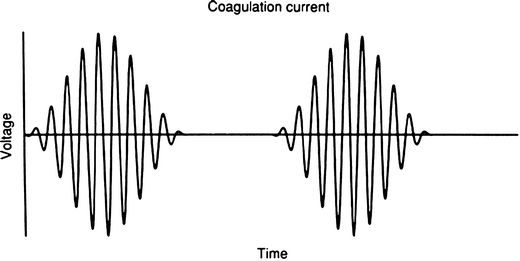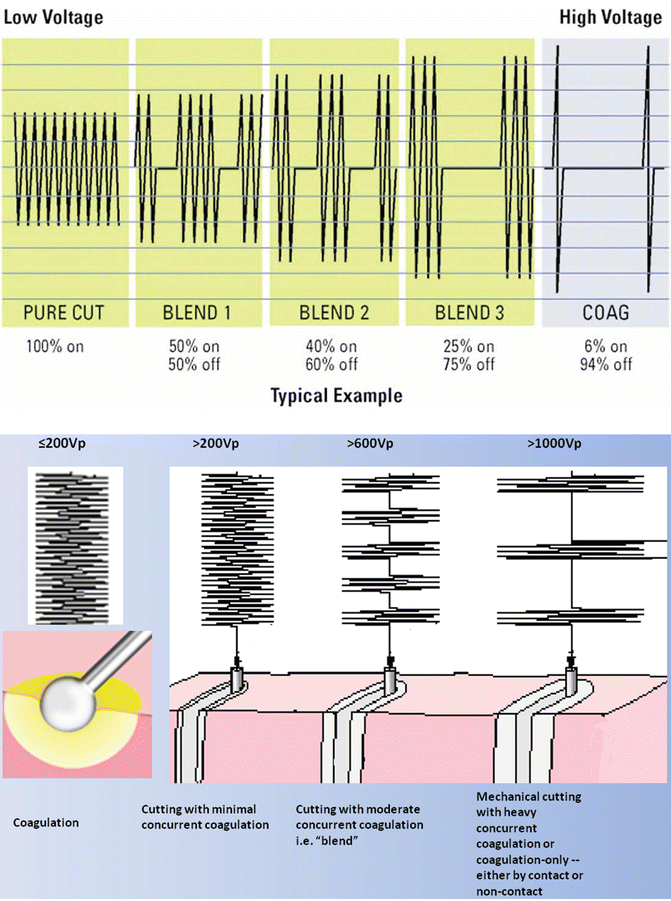Fig. 9.1
Cutting current
Coag
In general, coagulation current is produced by intermittent bursts of higher voltage alternating current (Fig. 9.2). The effect is a slower increase in temperature that induces the dehydration and denaturation of tissue without bursting cells (desiccation). This response creates a coagulation effect, with some cutting properties depending on the voltage, duty cycle (see Blend section), etc. Coagulation waveforms generally use voltages of approximately 1,000 Vp with very little current flow (relative to cut).


Fig. 9.2
Coagulation current
Two “specific termed” coagulation waveforms are: SOFT COAG, a voltage-controlled waveform of less than 200 Vp, which is used to create “pure coagulation without cutting;” and SPRAY COAG, a high voltage (4,000 Vp) current used more often in tunneling procedures other than ESD. These modes will be discussed later.
Blend
Blend current is created by changing the voltage and modifying the on and off ratio (duty cycle) of the current (Fig. 9.3). Duty cycle is the current on and current off percentage, as modulated by the ESU. The less duty cycles, the more coagulation the effect assumes. A pure cut current typically uses a 100 % duty cycle (current is always on); on the other hand, pure coagulation current typically uses a 6 % duty cycle (current is on only 6 % of the time and is off 94 % of the time). Various ESUs create a variety of voltage and duty cycles to provide the effect desired by the operator (physician), depending on the targeted tissue. It is prudent to understand the basis of the blend current in order to be able to expect the tissue effect created by the ESU. Review articles have summarized the variety of ESUs as well as having provided the properties of cut, blend, and coagulation [1, 2].


Fig. 9.3
Cut to coagulation wave form (courtesy of ERBE)
Tissue Response and Expected Result
Tissue effect is determined not only by the ESU output. During the endoscopic procedure a variety of factors have to be taken into account. As in Ohm’s law, voltage and resistance determine current. Factors important to consider for ESD are tissue resistance, current density, and contact time (application time), in addition to ESU output mode.
Tissue Resistance
Variable tissue has different tissue resistance; notably, high resistance is noted for adipose tissue or, for ESD-related issues, is created in the submucosa by fibrosis from previous biopsy or attempt at resection. Furthermore, as tissue dehydrates during application of electrocautery, or if it has less water content (e.g. fibrosis), tissue resistance increases and coagulation effect becomes more prominent than cutting effect even with the same ESU output, or more voltage is needed to create the same effect.
Current Density
Current density is the amount of current that goes through a standardized area. Current density is an important factor affecting desired effect. When target tissue goals are electrosurgical cutting, higher current density results in better cutting effect, regardless of waveform. The output should be adjusted to the expected current density created by the device and operator on the target tissue.
Contact Surface: Device
If the contact surface is small (e.g. cutting with the tip of a needle knife), current density becomes higher than it would be with a larger contact surface (e.g. cutting with the whole length of needle knife such as IT knife or a snare); therefore, it cuts the tissue more effectively without much coagulation effect.
Contact Surface: Amount of Tissue Targeted
The amount of tissue targeted is also important. Even with the same device, such as the Hook knife (Olympus, USA), for example, and the same ESU output, use of the long arm portion results in a larger amount of tissue contact than using only the L-shaped tip. The cutting effect is reduced, thereby creating more coagulation effect and sometimes causing a charring effect. Further, when the intent is to “cut” or “vaporize” target tissue, and a delay occurs due to low current density (or under powered), then even more—often unrecognized—thermal insult occurs.
Contact Time (Application Time): Speed of Device Movement and Duration of Application
Speed of movement of the ESD knife and application duration (foot step “on” time) determines the amount of current applied to the targeted tissue. Faster movement of an ESD knife often results in the gathering of more tissue, resulting in low current density and less cutting effect, and alternatively resulting in more thermal insult than cutting through the tissue. Slower, steady movement of an ESD knife with shorter bursts of “on” time generally creates a more controlled electrocautery application to target tissue; however, static application of electrocautery current often results in a tissue char effect that is usually not desired. Control of the movement speed of the ESD knife and directional tension on the tissue are, therefore, very important.
Understanding this concept is exceptionally helpful during ESD procedures since the operator can modify the current density freely to achieve the desired effect (e.g. cutting fibrous tissue without char, coagulating the vessels prior to cutting through, cutting with forced coagulation without char) by modifying the device, the amount of tissue to target, and the speed of device movement.
Computerized ESUs
We have seen tremendous advancement of ESUs recently. Addition of computer software within the ESUs has made the control of blend current more sophisticated. A variety of output modes have been created for ease of desired tissue response. The most widely used ESUs for ESD procedures are the ICC™ and VIO™ systems (ERBE, USA). The recently released Olympus ESG system has output modes with same or similar names (e.g. ForcedCoag, SoftCoag, and Pulse Cut), but are not all based upon the same generator algorithms. It is important to understand the technological outputs associated with any generator, as well as the rationale for choosing “what” and “when.” Other notable modes are SWIFT COAG®, DRY CUT™, and Spray coagulation [3]. Here, each mode is discussed based on ERBE ESU.
Stay updated, free articles. Join our Telegram channel

Full access? Get Clinical Tree







